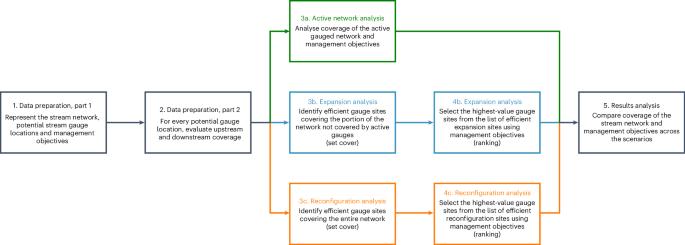可持续水资源管理的战略性测流网络设计
IF 25.7
1区 环境科学与生态学
Q1 ENVIRONMENTAL SCIENCES
引用次数: 0
摘要
监测河流和溪流水流的测流站为水资源管理者提供了重要信息,但由于测流站位置存在偏差和空白,再加上测流站停用,限制了我们跟踪河流水流和应对全球水资源挑战的能力。在此,我们介绍一种确定测量点的方法,以有效填补河网监测覆盖范围的空白,同时解决水管理优先事项,包括水库运行、生物多样性保护和水文气象监测。将这种方法应用于美国加利福尼亚州的测站,我们发现河流监测网络中存在大量空白。假设将水文站重新配置到能最大限度覆盖和代表管理目标的位置,就能突出当前网络的偏差。通过战略性地重新激活和放置更多的测量仪,我们展示了如何设计溪流测量网络以支持可持续的水资源管理。有效的水资源管理需要可靠的溪流数据,但这取决于溪流测量仪的覆盖范围。这项研究显示了目前的测量网络如何无法提供足够的覆盖范围,并探讨了修改后的网络如何能够支持大坝运行、生物多样性保护和气候监测。本文章由计算机程序翻译,如有差异,请以英文原文为准。

Strategic stream gauging network design for sustainable water management
Stream gauging stations that monitor the flow of water in rivers and streams provide critical information to water managers, but biases and gaps in gauge placement, compounded by gauge deactivations, limit our ability to track river flows and address global water challenges. Here we introduce an approach for identifying gauging sites to efficiently fill gaps in monitoring coverage within river networks while also addressing water management priorities, including reservoir operations, biodiversity conservation and hydroclimatic monitoring. Applying this approach to gauges in California, United States, we found substantial gaps in the stream monitoring network. Hypothetically reconfiguring gauges to locations that maximize coverage and representation of management objectives highlights the current network’s biases. Through the strategic reactivation and placement of additional gauges, we demonstrate how stream gauging networks can be designed to support sustainable water management. Effective water management requires reliable data on streamflow, but that hinges on the coverage provided by stream gauges. This study shows how current gauge networks fail to provide adequate coverage and explores how modified networks could support dam operation, biodiversity conservation and climate monitoring.
求助全文
通过发布文献求助,成功后即可免费获取论文全文。
去求助
来源期刊

Nature Sustainability
Energy-Renewable Energy, Sustainability and the Environment
CiteScore
41.90
自引率
1.10%
发文量
159
期刊介绍:
Nature Sustainability aims to facilitate cross-disciplinary dialogues and bring together research fields that contribute to understanding how we organize our lives in a finite world and the impacts of our actions.
Nature Sustainability will not only publish fundamental research but also significant investigations into policies and solutions for ensuring human well-being now and in the future.Its ultimate goal is to address the greatest challenges of our time.
 求助内容:
求助内容: 应助结果提醒方式:
应助结果提醒方式:


